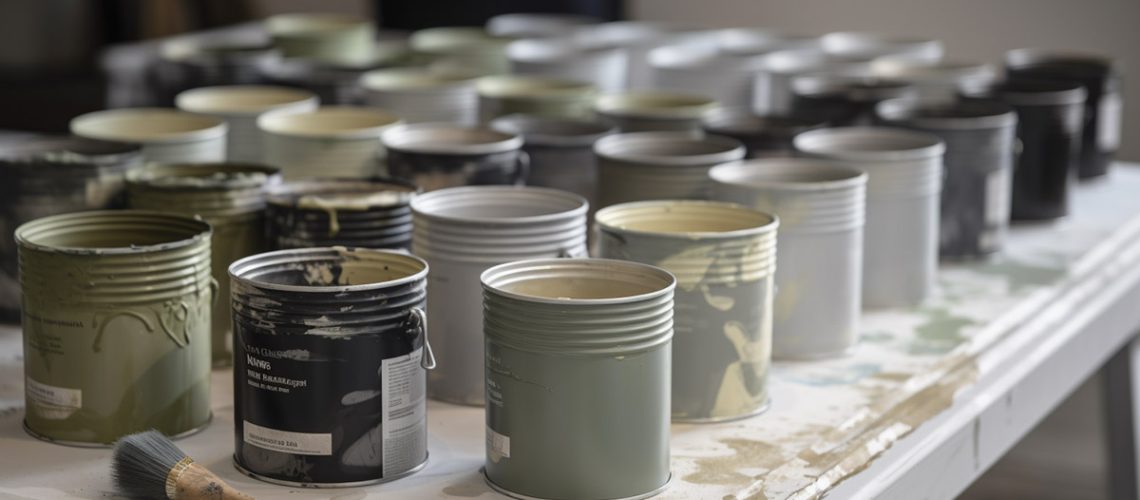Interior and exterior paints serve different purposes. The former focuses on aesthetics and indoor durability, while the latter prioritises UV protection and weather resistance. So what happens if you have leftovers? Can you mix interior and exterior paint?
Yes, you can! However, there are a couple of things to consider.
In this guide, we’ll look into these considerations and more. From the differences between these two paints to a couple of safety and health considerations, everything you need to know about mixing them is below.
Critical Differences Between Interior and Exterior Paint
Knowing the differences between interior and exterior paints is vital for any painting project. These include:
Composition and Ingredients
Interior and exterior paints have distinct compositions and ingredients from each other. The former prioritises stain resistance and ease of cleaning. The latter focuses on withstanding harsh outdoor conditions.
Performance
In terms of performance, the two are evenly matched. However, interior paint is designed to withstand the pressures of indoor living, emphasising smooth finishes and cleanability making it the best choice for your interior house painting project. Meanwhile, exterior paint is designed for outdoor protection, making it more durable (albeit just slightly), flexible, and sun-resistant.
Durability
High-quality interior and exterior paints are equally durable and designed to last for years. However, the latter is a shade more long-lasting due to its outdoor role.
Weather Resistance
Exterior paint is more resistant to the elements than its interior counterpart. This allows it to withstand severe weather conditions, including rain, snow, and sunlight exposure.
UV Protection
Additionally, exterior paint comes with better UV protection capabilities. This enables it to protect your property from the dangers of ultraviolet radiation, notably colour degradation and premature fading.
Potential Issues When Mixing Interior and Exterior Paint
At first glance, mixing interior and exterior paints is a great idea. And yes, you can indeed do so under certain circumstances (more on this below). However, it can lead to certain problems if you’re not careful. These include:
Poor Paint Quality
As mentioned above, interior and exterior paints have different compositions. Mixing these unique binders, pigments, and additives together might result in a chemical reaction that could compromise the paint’s overall quality.
Reduced Performance
Mixing interior and exterior paints can also hamper performance. This can result in reduced durability, premature fading, and cracking. If used outdoors, it might not be able to withstand UV rays or harsh weather conditions.
Poor Adhesion
The chemical reaction from mixing interior and exterior paint can often lead to poorer adhesion. Its side effects include peeling, flaking, and cracking, among others.
Inconsistent Appearance
Suppose the exterior and interior paint mixed have varying gloss and texture levels. The final product might result in uneven colouring and finishes in that case.
Health Hazards
Exterior paint contains higher levels of VOCs (Volatile Organic Compounds) than interior ones. If you apply the mixed paint indoors, it might cause you and your loved ones a plethora of health issues.
Instances Where Mixing Can Be Considered
The potential issues make mixing interior and exterior paint or primer a lousy idea. However, there are certain conditions where you can actually consider doing it (given careful circumstances). These include:
Limited Colour Options
Say you plan to paint your house’s exterior with a particular colour, and it’s only available for interior or exterior uses. In this case, you can mix the two together.
Small Touch-Up Projects
We also recommend mixing interior and exterior paints for smaller, touch-up projects. This allows for minimal damages if the combined paint somehow comes out wrong, enabling you to fix it quicker.
Experimental Projects
Mixing interior and exterior paints is also excellent for artistic or experimental projects. It basically allows you to try different combinations, as well as observe unpredictable outcomes.
High Compatibility
To mix paints in the first place, you need to understand their compositions, ingredients, and what-not. If you have interior and exterior paints that are very compatible with each other, then it’s safe to combine them into one.
Expert Recommendations
Before combining any paint, best talk to your trusted painting professional. They can help you minimise the potential risks and provide valuable insights and tips for mixing interior and exterior paints.
Best Practices for Mixing Interior and Exterior Paint
During your painting project, you’ll find yourself in a situation where you must mix interior and exterior paint. Follow these tips to minimise the potential issues and achieve the best results:
Test on a Small Area
Before applying the mixed paint on your door, window, wall, or any other part of your house, test it on a small area first. This could be a separate wooden plank, concrete slab, or a hidden spot in your property. Doing this will help you check the final colour and finish and evaluate its adhesion and performance.
Maintain Proper Ratios
You should follow the exact ratios and proportions when mixing interior and exterior paint. This will help you avoid imbalances that might ruin the paint’s appearance, quality, and performance. Consult your trusted professional or look at the paint can’s label for the recommended ratios and proportions.
Avoid Combining Contrasting Colours
Using shades that clash with each other is never a good idea. By combining these hues into one paint, you’re basically asking for trouble. Not only will the final result lack harmony, but it will also make your house look less appealing. This will result in poor aesthetics, lower quality of life, and decreased property resale value.
Do the Mixing Slowly (and Document the Process)
You should also avoid putting them in one container all at once. Instead, combine them in slow rounds. This will help you observe the colour and texture, make the necessary adjustments, and ensure the paints actually fuse together. For good measure, keep track of the amounts you added. This will help you mix paints in the future.
Label and Store Properly
After mixing the paints, you should label and store them accordingly. Make sure to slap large labels on the container and clearly write “Mixed Paint” and the mixing date on it. Then keep the container in a cool area for future use.
Best Paint Brands for Mixing Interior and Exterior Paint
Aside from the best practices listed above, you should choose the best paint brands and products. That way, you better ensure the best outcome. Here are some of the best brands to watch out for:
Sherwin-Williams
Sherwin-Williams offers a range of products suitable for both interior and exterior applications. Take their SuperPaint line, for example. Notable for its durability and smooth finish, it’s a fantastic product to mix together.
Benjamin Moore
Benjamin Moore is also highly regarded in the paint industry due to their durable and long-lasting results. Of particular note is their Regal Select, praised for its versatility and mixability.
Behr
Behr is renowned for its exceptional colour retention and resistance to cracking, peeling, and fading. Their Premium Plus Ultra is praised for its outstanding coverage and durability. Meanwhile, their Marquee line is designed for interior and exterior use, allowing you to mix it when needed.
Dulux
As a household name in Australia, Dulux offers several interior and exterior products suitable for mixing. For example, their Dulux Wash&Wear line is notable for excellent washability and durability. On the other hand, their Weathershield range is designed to withstand harsh outdoor conditions.
Taubmans
Taubmans offers quality paints that cater to both interior and exterior needs. Their Endure line is known for its longevity and durability, making it a potential choice for mixing projects.
Safety and Health Tips When Mixing
Mixing interior and exterior paints can be a practical solution in many cases; there’s no doubt about it. However, it’s crucial to prioritise your safety and health throughout the process. Here are a couple of tips to follow:
Ensure Proper Ventilation
Mixing paints exposes you to fumes and chemicals. By keeping your work area well-ventilated, you can minimise the presence of these harmful gases.
Wear PPEs
Don the appropriate Personal Protective Equipment (PPE) before you get started. These include gloves, safety goggles, and a mask. You should also wear long sleeves and pants to minimise skin exposure.
Check Chemical Compatibility
Certain paints have formulations that can result in interesting chemical reactions. So before you get started, familiarise yourself with the products’ composition and ingredients. That way, you can achieve the correct interaction between the interior and exterior paints.
Watch Out for VOCs
Both interior and exterior paints contain VOCs. As mentioned above, these can pose a risk to you and your loved ones if you’re not careful. The Environmental Enhancement through High-Rise Building Refurbishment also noted lower VOCs can make living spaces more comfortable and guarantee healthy indoor air quality. So check the VOC level of the products you’re using beforehand.
Seek Medical Attention
Even with careful preparation, accidents can still happen. If you find yourself dealing with allergic reactions or other health problems while mixing paint, get medical attention immediately.
Frequently Asked Questions
Can interior paint be used on exterior surfaces?
Technically speaking, you can. However, most experts don’t recommend doing so. So even if it’s cheaper, quicker, and more available, you should paint your outdoor surfaces with something other than interior paint.
Why can’t you use interior paint outside?
Because interior paint isn’t designed for outdoor use. It couldn’t withstand outdoor challenges like rain, UV rays, and temperature fluctuations. If you proceed with it anyway, you’ll find yourself dealing with premature compromised protection against the elements, not to mention fading, peeling, and what-not.
Can exterior paint be used indoors?
Yes, you can apply exterior paint indoors. However, bear in mind that it might leave your home with a strong odour (due to its weather-resistant components). Additionally, exterior paint has higher VOC levels than interior paint. Applying it inside your home could lead to health issues.
What happens if you mix exterior and interior paint?
That will depend on which products you use and how you mix them. If done correctly, you’ll still be able to achieve the best results for your painting project. But if done wrong, it could leave you with poorer finishes and truckloads of problems to boot.
Conclusion
So back to the main question. Can you mix interior and exterior paint?
The TL;DR is yes!
There’s no rule saying you shouldn’t! However, you should know that doing so can lead to potential issues, from uneven colouring to VOC exposure. So if you plan to mix leftover products, do it under the right circumstances and follow the best practices and safety tips.
Following the guide above will help you properly mix interior and exterior paint. To achieve the best results for your painting project, check out what we have to say before getting started.

